This article was published in Scientific American’s former blog network and reflects the views of the author, not necessarily those of Scientific American
Arguably among the weirdest and most exciting of extinct Cretaceous creatures are the giant azhdarchids, a group of enormous pterosaurs that were, as a generalisation, long-necked, stork-billed animals equivalent in quadrupedal standing height to a good-sized giraffe. As will be familiar to the majority of readers here, azhdarchids were variously considered vulture-like terrestrial scavengers, marine skim-feeders or dip-feeders, heron analogues or sandpiper analogues prior to 2008. That was the year in which Mark Witton and I argued that anatomical, trackway and environmental data better supported a model of azhdarchids as terrestrial stalkers: as proficient, narrow-gauge terrestrial walkers that foraged in Cretaceous environments, reaching down to pick up and swallow small vertebrates and whatever else took their fancy (Witton & Naish 2008, 2015, Witton 2013). Such a view is by no means inconsistent with the giant wingspans (of c 10 m) and excellent soaring abilities of these animals.
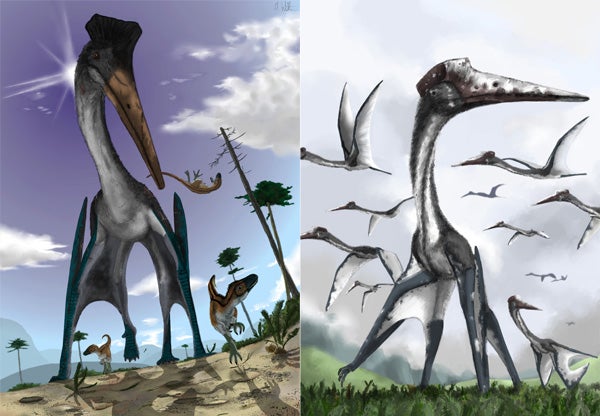
Giant, long-necked azhdarchids depicted within the terrestrial stalking paradigm as per Witton & Naish (2008). Newsflash: not all azhdarchids looked like this. Credit: Mark Witton
In 2002, Eric Buffetaut and colleagues named the new giant azhdarchid Hatzegopteryx thambema from the Maastrichtian Densuş-Ciula Formation of the Haţeg Basin, Romania (Buffetaut et al. 2002). The remains included the occipital region of the skull (and part of the palate) and a giant humerus (Buffetaut et al. 2002, 2003). Since then, numerous additional giant azhdarchid remains have been discovered in Romania, many from the Sebeş region of the Transylvanian Basin, east of the Haţeg Basin. These shed substantial additional information on the anatomy and diversity of Romanian azhdarchids (see citations in Vremiret al. 2013, 2015).
On supporting science journalism
If you're enjoying this article, consider supporting our award-winning journalism by subscribing. By purchasing a subscription you are helping to ensure the future of impactful stories about the discoveries and ideas shaping our world today.
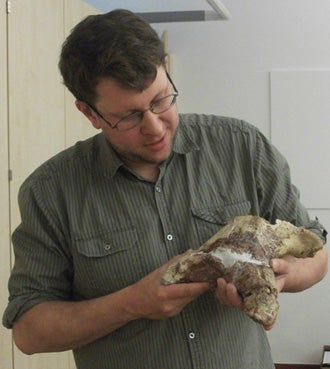
EME 315 with a human to scale. Credit: Darren Naish
Among these remains is a very interesting cervical vertebra – specimen EME 315 (of the Transylvanian Museum Society, Cluj-Napoca, Romania) – discovered by Matyas Vremir at the amazing Râpa Roşie locality. In a new paper published within the open-access journal PeerJ, Mark Witton and I explain how this specimen presents us with a new, dynamic view of Hatzegopteryx, and with an improved understanding of azhdarchids in general (Naish & Witton 2017). EME 315 is not a new discovery, and in fact was first described back in 2010 (Vremir 2010). It’s our interpretation and analysis of it that’s new.
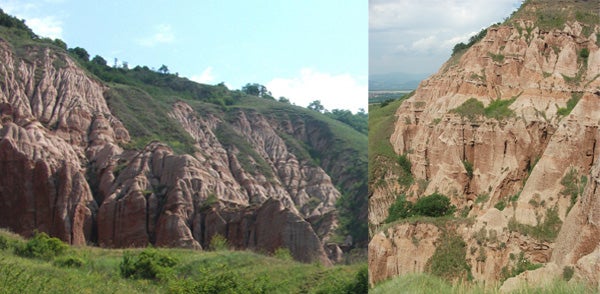
Scenes from Râpa Roşie, a name meaning 'red ravine', near Sebeş, Romania. Credit: Darren Naish
To start with, what’s with our proposal that the Transylvanian Basin azhdarchid remains are attributable to Hatzegopteryx? Both the Haţeg Basin and Transylvanian Basin remains possess the same spongiose internal bone texture, they’re consistent in size, and they’re geographically and stratigraphically close enough to suggest synonymy. Furthermore, we haven’t yet found any places in the world where two giant azhdarchid taxa were sympatric. Admittedly, identification of the Transylvanian Basin material as Hatzegopteryx is provisional and pends on the discovery of material that overlaps with the Hatzegopteryx holotype. Nevertheless, it seems like a strong argument to me: we should assume for now that all the giant Romanian azhdarchid material pertains to the same one taxon (Naish & Witton 2017).
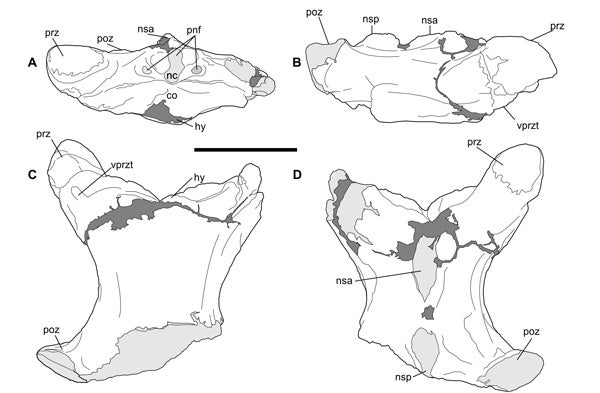
Diagrams of EME 315 in (A) anterior, (B) right lateral, (C) ventral and (D) dorsal views. The grey regions show breakage and missing bone. Scale bar = 10 cm. Credit: Naish & Witton 2017
Anatomically, EME 315 is remarkable for several reasons. It’s large and chunky overall, short and broad for an azhdarchid vertebra, and with especially thick bone walls. Much of the neural spine is missing, but its base shows that it was bifid, consisting of two distinct sections separated by a gap in the middle. The bone that forms the ventral surface of the vertebral body (or centrum) is – at between 4 and 6 mm (depending on where you measure it) – extremely thick for a pterosaur. A more normal bone thickness would be 2.6 mm or less. Oh, and EME 315 is definitely from an azhdarchid: no other group of animals possess the shallow centrum, large, flattened zygapophyses (the prong-like structures that articulate with a pair of matching structures on the adjacent vertebra) and bifid (two part) neural spine present here. The pneumatic structures and so on are also consistent with an azhdarchid identification.
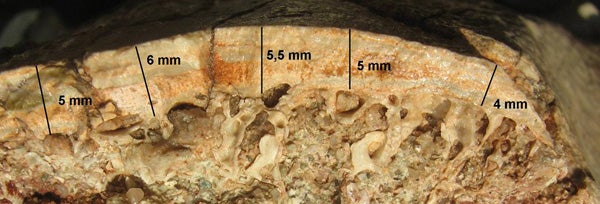
The thick bone wall along the ventral surface of EME 315 (the specimen is here inverted). Credit: Darren Naish
Neck proportions and neck length. Identifying an isolated vertebra – I mean, working out the position of a given vertebra within the neck series – is somewhat challenging. Having said that, a number of specific details pertaining to proportions, neural spine anatomy, prezygapophyseal anatomy, the presence and distribution of pneumatic foramina, and the presence or absence of a ventral structure termed the hypapophysis allow us to work out the likely positions of isolated azhdarchid vertebrae. On this basis, we reject a previous proposal that EME 315 might be a cervical III (Vremir 2010) and instead find that it possesses a list of features identifying it as cervical VII (Naish & Witton 2017). We could be wrong on that, but it’s well supported by what we know right now.
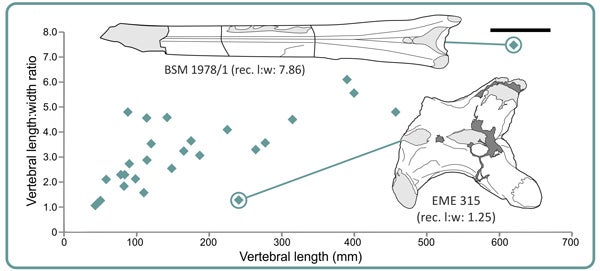
Here's how EME 315 matches up to other azhdarchid cervical vertebrae as goes length to width ratios - it's clearly an outlier. We can say similar things for the extremely elongate cervical vertebra of Arambourgiania, shown at the top. Credit: Naish & Witton 2017
Identified as such (as a cervical VII; CVII for shorthand), EME 315 can be used to make some extrapolations about the remaining proportions of this animal. Associated neck vertebrae from other azhdarchids (in particular Phosphatodraco from Morocco) show us what the proportional relationship is like between CVII and other vertebrae, and between the length of CVII and the better part of the neck as a whole.
It turns out that the whole neck must ‘only’ have been about 1.5 m long, which is low compared to the overall size of the animal, and low compared to what we calculate for large azhdarchids with much longer cervical vertebrae (Naish & Witton 2017). In contrast, Arambourgiania – a large Middle Eastern azhdarchid named for a very slender CV perhaps 77 cm long when complete – would have had a neck about 2.6 m long. Incidentally, the relationship between CVII and CV known for other azhdarchids indicates that the unknown CV of Hatzegopteryx would have been about 41 cm long. So, about half that of Arambourgiania. Again, the concept of short-neckedness for the animal represented by EME 315 is not novel to our study but has been around for a while (Vremir 2010).
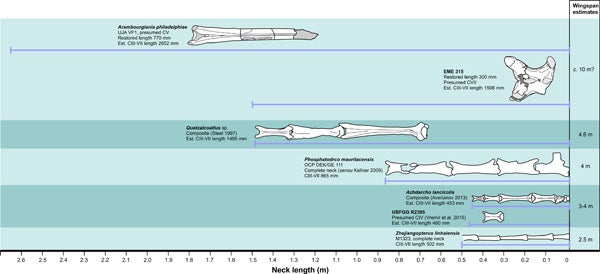
EME 315 (the chunky bone at upper right) and other azhdarchid cervical vertebrae with estimated neck lengths and wingspans. See Naish & Witton (2017) for the full-size version. Credit: Naish & Witton 2017
So by now it’s looking likely that we have markedly slender-boned, long-necked azhdarchids on the one hand, and thick-boned, short-necked azhdarchids on the other. And remember that this is not the only indication we have of relative robust-neckedness in azhdarchids: we have in the past proposed the presence of a relatively short, stocky neck in R.2395, a small (currently unnamed) azhdarchid taxon from Romania (Vremir et al. 2015).
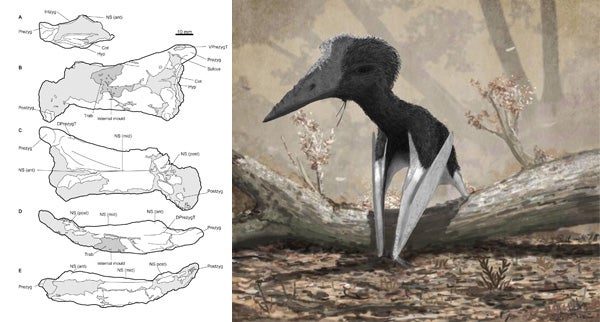
There have been indications for a while that at least some azhdarchids might have been shorter in the neck than traditionally envisioned. The neck vertebra at left is R.2395, 89 mm long, from the Haţeg Basin, described by Vremir et al. (2015). At right is Mark Witton’s life reconstruction of this animal. Credit: Mark Witton, Vremir et al. 2015
It’s significant that this notion of a robust-necked giant azhdarchid is consistent with the other data we have on Hatzegopteryx. The Hatzegopteryx holotype skull is robustly constructed and broad, being an impressive 50 cm wide across the jaw joints and with an occipital condyle (5.5 cm wide) exactly proportional to the 15-cm-wide articulate face of EME 315. As Mark has emphasised elsewhere, a long-jawed, giant animal with 50-cm-wide jaws is, potentially, a formidable predator that could have swallowed reasonably big animals. Like, human-sized animals. That’s not a ridiculous idea when you consider the food items swallowed by storks, herons and other modern birds superficially similar to azhdarchids in head and neck anatomy.

Skeletal reconstructions of the giant azhdarchids (A) Hatzegopteryx and (C) Arambourgiania to scale, showing the markedly different body shapes seemingly present in these animals. (B) shows how broad the back of the skull and neck was in Hatzegopteryx. Contrast this with D-E: the small Quezalcoatlus species (soon to be named), with its 4.6 m wingspan and long, slender neck. Scale bar = 1 m. Credit: Naish & Witton 2017
Neck strength. Do the proportions and dimensions of EME 315 allow us to say anything specific about the way the neck worked in this animal? The uncrushed, three-dimensional form of this bone, its intact bone walls, and its relatively simple elliptical cross-section inspired the idea that we might be able to investigate its mechanical strength, the aim being to see how much load it (and thus the whole neck) could handle.
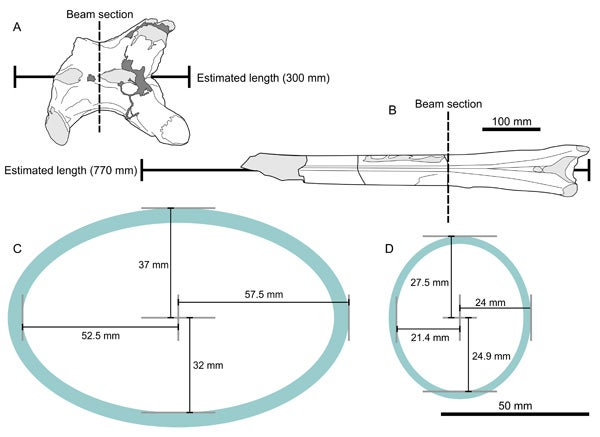
Cross-sectional data and bone thickness from EME 315 (at left) and Arambourgiania (at right) show that EME 315 was highly capable of dealing with heavy loads. Credit: Naish & Witton 2017
There’s enough existing research on the strength of pterosaur bone to make this possible, and after crunching the numbers, the indications are that EME 315 was highly resistant to loading, bending and deformation, so much so that Hatzegopteryx was potentially able to resist the transferring of its entire body weight through this one bone alone (Naish & Witton 2017). This is consistent with the presence of a presumably large, relatively heavy skull, but also with the possibility that this pterosaur was capable of picking up objects quite a bit heavier than those handled by other azhdarchids.
A thicker, deeper, more muscular neck. A related point we also make in the paper – and this is essentially the first time it’s properly been made in the technical literature – is that the neck in the live animal would have been substantially thicker and deeper than indicated by vertebrae alone. There’s good evidence, both from the anatomy of living archosaurs, and from the bones of azhdarchids, that a number of muscles were not just present, but well developed and prominent (Naish & Witton 2017).
All of this might seem obvious if you’re familiar with the soft tissues of the tetrapod neck but it’s a subject all too often ignored in palaeontology, the tradition until recently being to imagine the azhdarchid neck as little more than a rod-like beam of vertebrae encased in a thin veneer of skin. Both the (broken) neural spine of EME 315 and the deep, prominently scarred occipital region indicate that the neck had some reasonably depth – it wasn’t just broad.
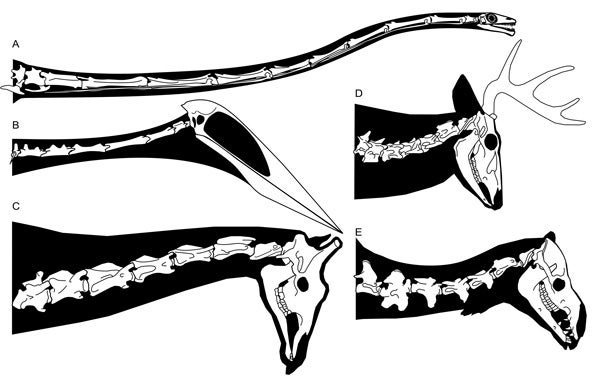
Azhdarchid cervical vertebrae are weird, but they might not be as weird as has often been portrayed: there's plenty of evidence there for the musculature otherwise typical for tetrapods. Tanystropheus (A) and kin took an azhdarchid-style trend to an extreme. (B) Zhejiangopterus, (C) Giraffa, (D) Odocoileus, (E) Camelus. Credit: Naish & Witton 2017
The bigger picture: of robust-necked top-tier predators. As should be obvious by now, we propose a view of Hatzegopteryx as a giant, robust-necked, heavily built azhdarchid, well adapted to terrestrial predation, and capable of handling and swallowing relatively large prey items (Naish & Witton 2017). In our previous work on azhdarchids, we’ve imagined large species as predators of vertebrates and large invertebrates up to the size of, say, a domestic cat. For Hatzegopteryx, we consider it plausible that it was grabbing and tackling animals of tens of kilos. Small dinosaurs – up to the size of humans – were very plausibly on the menu for this animal.
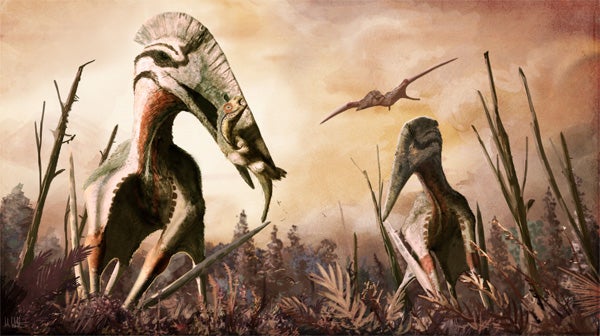
Hatzegopteryx reconstructed as a robust-necked top-tier predator, capable of grabbing and dispatching dinosaurs like the unfortunate Zalmoxes shown here. Image by Mark Witton. Credit: Mark Witton, Naish & Witton 2017
A peculiar thing about the Maastrichtian faunas of Romania is that large theropods are absent, the biggest being the paravian Balaur, and it was less than 2 m long (and quite probably not a dedicated predator anyway: see Cau et al. (2015) and this Tet Zoo article for more). Nothing in the way of large theropods has been discovered in the relevant strata so far – not even a single tooth (the Megalosaurus hungaricus teeth often listed as being from the Haţeg Basin are not, but are actually from older rocks).
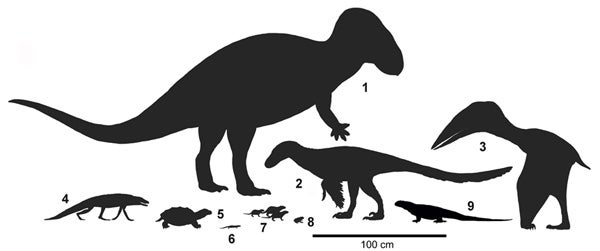
Some of the vertebrates that would have been contemporaneous with Hatzegopteryx: they include ornithischian and maniraptoran dinosaurs, crocodyliforms, turtles, mammals, lissamphibians, lizards and smaller pterosaurs. This diagram is a from a manuscript that will probably never see publication. Credit: Darren Naish
So, did azhdarchids occupy the role of top-tier terrestrial predator?* We compiled the hypothesis of Hatzegopteryx as a top-tier predator on the basis of the anatomical evidence discussed here (and in the paper), not because we were looking for animals that might fill an otherwise empty niche. But, yes, there might be something in this: giant azhdarchids might, in some places, have evolved to fill a niche elsewhere occupied by large theropods.
* An aside on terminology. We originally used the term ‘apex predator’ in the title of our paper, the intended meaning being that the animal might have been the largest predator in its ecosystem; the one species that was not, itself, at risk of predation from anything else. But we changed this since a colleague and reviewer rightly pointed out that ‘apex predator’ is actually used in a specific way in the ecological literature: it refers to predators that consume other predators and do not have predators themselves (this use of the term is commonest in the literature on marine ecology). We therefore opted to go with ‘arch predator’, this being (so we assumed) a vernacular term, again, for ‘top predator in the ecosystem’. This was also then questioned, apparently by people who thought that we were describing the animal as a predator of arches. Personally, I think it’s obvious what we meant: ‘apex predator’ is not applied as specifically as it should be according to the version preferred by marine ecologists, and ‘arch predator’ is neither, from my reading, unfamiliar nor difficult to understand.
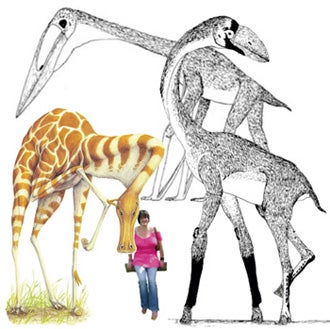
Flightless azhdarchids: long the stuff of speculation. None of the animals shown here are real, especially not the Lank from Dougal Dixon's The New Dinosaurs. Credits: Steve Holden, Darren Naish
An inevitable question that arises whenever these giant, island-dwelling, seemingly predatory azhdarchids are discussed is: were they flightless? Several pterosaur workers have already suggested, informally at conferences and technically in print (Henderson 2010), that giant azhdarchids of some species might have been flightless. As yet, however, there’s no anatomical support for this, and what we know of their skeletons indicates that they were fully flight-capable. I should also add that the additional – unpublished – skeletal material from Romania, alluded to above, has some bearing on this.
Finally, long-time readers with really, really good memories might recall that an initial corollary of our terrestrial stalking hypothesis was that all azhdarchids were essentially alike as goes proportions, bar variation in size (Witton & Naish 2008). We can now say that this is incorrect, and that the group does indeed include some modicum of variation in overall robustness and in neck form and neck length, at least (I should also say that Dave Unwin made some references to this variation in his 2005 book The Pterosaurs From Deep Time). Indeed, we can’t say for sure what Hatzegopteryx was like overall, nor do we know enough to make confident pronouncements on its size or wingspan, though we assume that it was similar in wingspan to other giants.
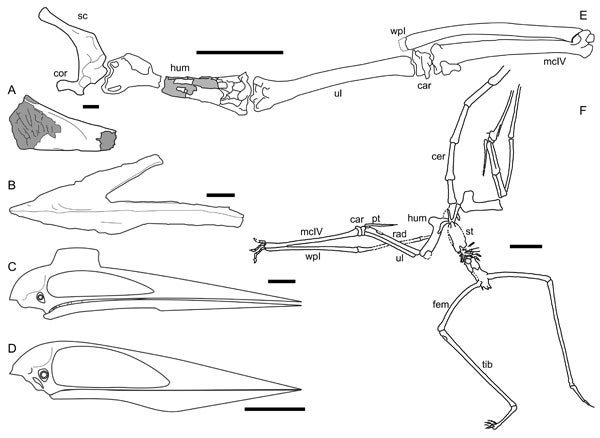
It turns out that it's not one-size-fits-all for Azhdarchidae. There's some reasonable anatomical disparity within this group, as shown in this diagram comparing rostrum form (A-D) and wing proportions (E-F). Credit: Naish & Witton 2017
Remember that you can download the full technical paper yourself here. Mark’s take on the paper is here. This story has been quite popular and widely covered by the media. For reasons I do not intend to discuss, I did not talk to any journalists on this story, and all the promotion and reporting you’ve seen happened without my involvement. A result is that some of the news articles have been hilariously bad; I especially enjoyed those that referred to Hatzegopteryx as a T. rex-like giant bird that ate prehistoric horses. Sigh.
Additional azhdarchoid-themed work is underway right now and more on these amazing animals will be discussed here in time.
For previous Tet Zoo articles on azhdarchids and other azhdarchoid pterosaurs, see…
The Cretaceous birds and pterosaurs of Cornet: part II, the pterosaurs
What does it feel like to get bitten by a ground hornbill, I hear you ask?
A new azhdarchid pterosaur: the view from Europe becomes ever more interesting
Daisy’s Isle of Wight Dragon and why China has what Europe does not
Quetzalcoatlus: the evil, pin-headed, toothy nightmare monster that wants to eat your soul
Refs - -
Buffetaut, E., Grigorescu, D. & Csiki, Z. 2002. A new giant pterosaur with a robust skull from the latest Cretaceous of Romania. Naturwissenschaften 89, 180-184.
Buffetaut, E., Grigorescu, D. & Csiki, Z. 2003. Giant azhdarchid pterosaurs from the terminal Cretaceous of Translyvania (western Romania). In Buffetaut, E. & Mazin, J.-M. (eds) Evolution and Palaeobiology of Pterosaurs. Geological Society Special Publication 217. The Geological Society of London, pp. 91-104.
Henderson, D. M. 2010. Pterosaur body mass estimates from three-dimensional mathematical slicing. Journal of Vertebrate Paleontology 30, 768-785.
Vremir, M. 2010. New faunal elements from the Late Cretaceous (Maastrichtian) continental deposits of Sebeş area (Transylvania). Acta Musei Sabesiensis 2, 635-684.
Vremir, M., Witton, M., Naish, D., Dyke, G., Brusatte, S. L., Norell, M. & Totoianu, R. 2015. A medium-sized robust-necked Azhdarchid Pterosaur (Pterodactyloidea: Azhdarchidae) from the Maastrichtian of Pui (Haţeg Basin, Transylvania, Romania), American Museum Novitates 3827, 1-16.
Witton, M. P. 2013. Pterosaurs. Princeton University Press, Princeton & London.